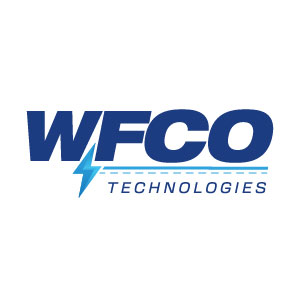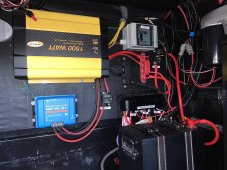quadna71
New Member
- Joined
- Jan 21, 2022
- Messages
- 36
I’m planning to increase the available 12v power to my RV but am not dabbing in solar yet. We only need the ability to get a couple days off-grid as we spend one or two nights in the camper while traveling longer distances from origination to destination and then are plugged back into shore power and can charge back up. So maybe solar down the road but not for now. The largest draw on our system is a 12v residential fridge (11 amp peak use) and after that the occasional cycle of the water pump to use the toilet/sink while at a rest stop. I’ve ordered the parts and am ready to start the install….and then of course I came across this forum. So in hindsight, I’d like to list my parts of the project and hopefully some more experienced folks can chime in and let me know if I’m on the right track.
Current setup:
70ah (group 37) 12v FLA battery on the tongue of the travel trailer - it has reached end of life and helped time the start of this project.
WFCO 55 amp charger/converter in the power panel with 3-stage charging for FLA batteries only.
Battery shut off in the front pass-thru storage compartment.
Planned upgrade setup:
Two 206ah SOK batteries in parallel secured inside under the bed.
WFCO 50 amp charger/converter in the power panel with 2-stage charging for LiFePO4 batteries only.
Battery shut off in the front pass-thru storage compartment.
Second battery shut off under the bed right after the positive cable leaves the batteries.
60 amp fuse located on the positive just after the battery shut off.
Victron Smartshunt on the negative cable right after the negative cable leaves the batteries.
The cabling is 2awg Windy Nation with 100% copper lugs. I have a good crimper, heat shrink, a heat gun and have been practicing a couple times.
So I think that is all I need to very simply increase my battery size. The OEM battery cable is 8awg, so while the 2awg I’m using isn’t as big as some folks use, it is still a good upgrade from what is already in place. I’m putting the battery shut off in place near the batteries because it is highly recommended, but I’m also leaving the battery shut off in the front pass-thru storage compartment. This is because when the slide is fully retracted the bedroom is inaccessible (where the batteries will live) and I still want the ability to kill the system easily without having to resort to using shore power to close the slide back up after killing the batteries from under the bed. While I know there are better charger options out there, using the WFCO replacement seems to be a simple swap and involves the least changes to the RV. I chose the Smartshunt so that I can monitor the batteries from my phone as a wired monitor would be less convenient to check by lifting the bed up all the time.
Okay. Thoughts? Screwed up? The right direction? Changes?
As an aside, I do have a small Renogy 100w suitcase solar kit with controller that can be placed outside and plugged in. But since we will likely be traveling during the day it won’t really be an impactful solution in this case. Solar could be an option next year (2023-24) but for now I’m only interested in the batteries. Lastly, I thought I should mention that we do not have an inverter nor do we plan to install one. So no 120v appliances to draw on the system at all. Just the fridge, an occasional cycle of the water pump, and maybe an LED light or two in the evening while parked at a Harvest Host location or someplace like that.
Thank you.
Current setup:
70ah (group 37) 12v FLA battery on the tongue of the travel trailer - it has reached end of life and helped time the start of this project.
WFCO 55 amp charger/converter in the power panel with 3-stage charging for FLA batteries only.
Battery shut off in the front pass-thru storage compartment.
Planned upgrade setup:
Two 206ah SOK batteries in parallel secured inside under the bed.
WFCO 50 amp charger/converter in the power panel with 2-stage charging for LiFePO4 batteries only.
Battery shut off in the front pass-thru storage compartment.
Second battery shut off under the bed right after the positive cable leaves the batteries.
60 amp fuse located on the positive just after the battery shut off.
Victron Smartshunt on the negative cable right after the negative cable leaves the batteries.
The cabling is 2awg Windy Nation with 100% copper lugs. I have a good crimper, heat shrink, a heat gun and have been practicing a couple times.
So I think that is all I need to very simply increase my battery size. The OEM battery cable is 8awg, so while the 2awg I’m using isn’t as big as some folks use, it is still a good upgrade from what is already in place. I’m putting the battery shut off in place near the batteries because it is highly recommended, but I’m also leaving the battery shut off in the front pass-thru storage compartment. This is because when the slide is fully retracted the bedroom is inaccessible (where the batteries will live) and I still want the ability to kill the system easily without having to resort to using shore power to close the slide back up after killing the batteries from under the bed. While I know there are better charger options out there, using the WFCO replacement seems to be a simple swap and involves the least changes to the RV. I chose the Smartshunt so that I can monitor the batteries from my phone as a wired monitor would be less convenient to check by lifting the bed up all the time.
Okay. Thoughts? Screwed up? The right direction? Changes?
As an aside, I do have a small Renogy 100w suitcase solar kit with controller that can be placed outside and plugged in. But since we will likely be traveling during the day it won’t really be an impactful solution in this case. Solar could be an option next year (2023-24) but for now I’m only interested in the batteries. Lastly, I thought I should mention that we do not have an inverter nor do we plan to install one. So no 120v appliances to draw on the system at all. Just the fridge, an occasional cycle of the water pump, and maybe an LED light or two in the evening while parked at a Harvest Host location or someplace like that.
Thank you.





